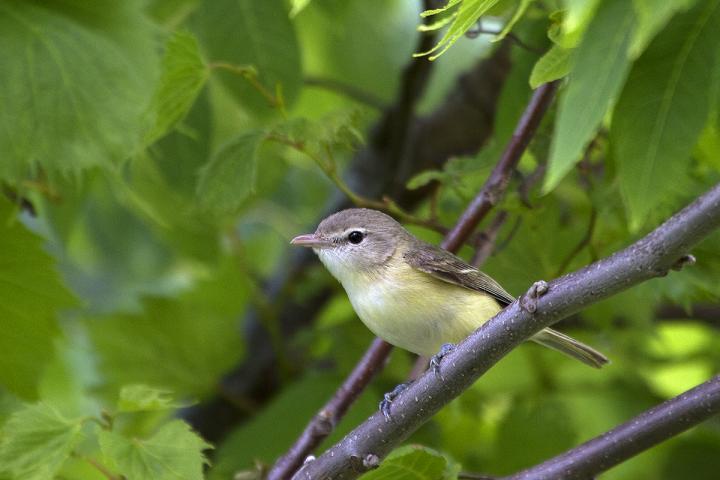
Credit: Photo by Michael Jeffords and Sue Post
CHAMPAIGN, Ill. — Land conservation programs that have converted tens of thousands of acres of agricultural land in Illinois back to a more natural state appear to have helped some rare birds increase their populations to historic levels, a new study finds. Other bird species with wider geographic ranges have not fared as well, however.
The research, reported in the journal Ecosphere, finds that one of the four species studied, the Bell’s vireo (Vireo bellii bellii), has bounced back from historic declines to more than double its last estimated abundance in Illinois.
“This increase surpasses state goals set for the bird in 2004, and speaks to some of the successes of the Conservation Reserve Enhancement Program, a national effort begun in 1996 to improve water quality, reduce erosion and restore lands and wildlife once lost to agricultural expansion,” said Illinois Natural History Survey avian ecologist Bryan Reiley, who led the study. “Other rare birds – particularly those most reliant on early succession grasslands – are still struggling, however.”
The growth of agriculture “has negatively affected biodiversity throughout the world,” the study authors wrote. Grassland species have experienced some of the sharpest declines. Conservation programs like CREP use monetary incentives to entice private landowners to voluntarily convert some of their land back to grasslands, wetlands or forest. More than 140,000 acres have been restored so far in Illinois through CREP.
To determine how this conservation effort affects populations of specific rare birds, Reiley and his colleagues surveyed 172 randomly selected restored fields in 10 counties in central and west-central Illinois during the 2012-15 breeding seasons. They focused on the Bell’s vireo and three other species in decline: the field sparrow (Spizella pusilla), northern bobwhite (Colinus virginianus) and willow flycatcher (Empidonax trailli trailli).
“We found that private land conservation efforts in Illinois are probably effective in achieving state population goals for some rare species, such as the Bell’s vireo, which prefers shrubby areas near grasslands,” Reiley said. “They also may help other species with similar habitat needs, like the willow flycatcher, which we estimate to be at 92 percent of the goal.”
The field sparrow and northern bobwhite still appear to be in trouble, however. Based on the researchers’ estimates, CREP has increased northern bobwhite populations by only 6 percent of the goal. Field sparrow abundance is better, but the conservation program has achieved only 33 percent of the goal for this species.
Reiley and his colleagues estimated that the amount of restored land would need to increase by 5 percent to rebuild populations of willow flycatchers to historic levels. Substantially more habitat would be required to support historic populations of field sparrows and northern bobwhites, however. To achieve state goals, those species would need habitat increases of 118 percent and 598 percent, respectively, the researchers found.
“Interestingly, all the species we studied, and probably many others not studied, would likely rebound to historic levels if 1 percent of the agricultural land in Illinois was restored through CREP,” Reiley said. “This program is clearly important to populations of declining wildlife – not only in Illinois, but also in the other 26 states where it operates.”
###
The Illinois Natural History Survey is a division of the Prairie Research Institute at the University of Illinois. The Illinois Department of Natural Resources supported this work.
Editor’s notes:
To reach Bryan Reiley, email [email protected].
The paper “Are avian population targets achievable through programs that restore habitat on private lands?” is available online and from the U. of I. News Bureau.
Michael Jeffords and Susan Post are wildlife photographers and research affiliates of the Illinois Natural History Survey at the Prairie Research Institute of the U. of I. Their photographs are available here.
Media Contact
Diana Yates
[email protected]
217-333-5802
Related Journal Article
http://dx.




